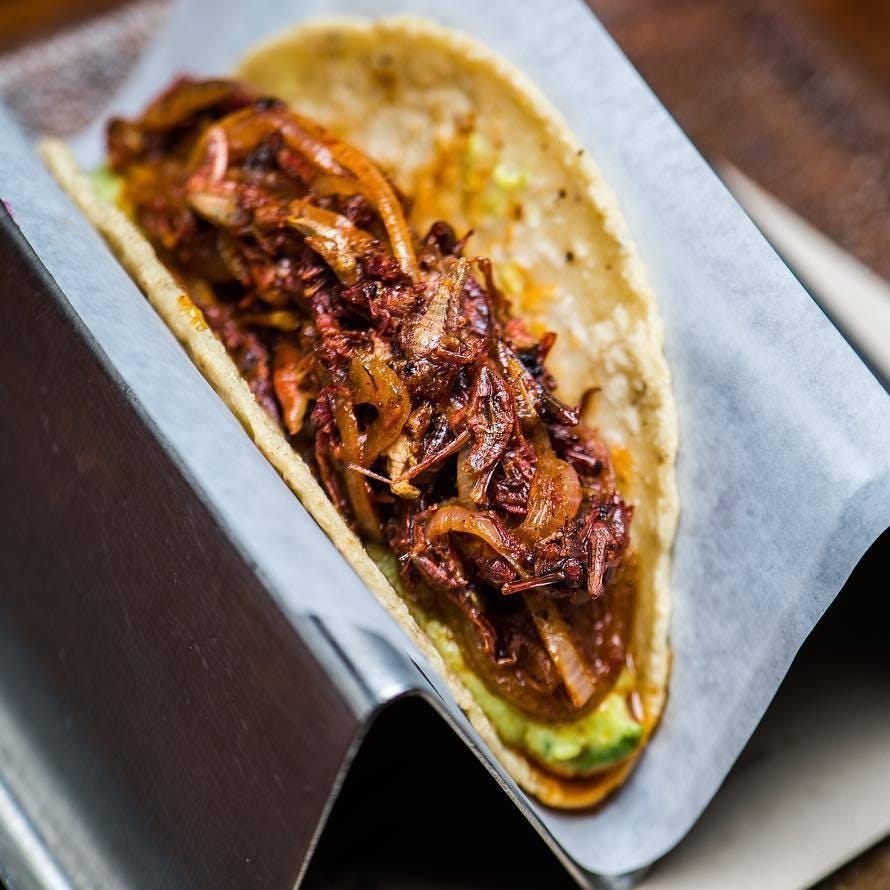
At dinner in Washington DC one night, I tucked into grasshoppers. You, too?
It wasn’t the first time. I’d munched them off a wide tin tray thrust under the window of the bus I was travelling in down the Mekong Delta while it waited to load onto a ferry. They had been marinated in soy sauce, garlic and ginger then roasted, additions without which, frankly, they would just have tasted of crunch and far less palatable than the stir-fried mayflies the Hmong family I stayed with in the highlands of Lao had guzzled with delight.
None of my beetle-fest experiences have turned me into a fully-fledged fan of acridology, the consumption of grasshoppers, locusts and related insects. And I can't reassure you that any of them tasted remotely like chicken.
But they weren't that much different from those delectable tiny grey shrimps they offer you to munch with your aperitif anywhere near the French coast. Indeed, they’re known to some as land shrimps for their body-shape similarity.
19th-century geologist-ethnologist John Wesley Powell, studying the eating habits of the Ute and Southern Paiute Native Americans living on the arid Colorado plateau, found grasshoppers and crickets an essential part of their diet. They were roasted then ground into meal for cooking into cakes or mush.
In 1984, archaeologists from the Utah State Historical Society investigating the deposits left by prehistoric people in a cave at the edge of the Great Salt Lake found tens of thousands of grasshopper fragments. Not surprising, perhaps: insects die. But among the layers of them in the sand were specimens of dried human feces stuffed with grasshopper parts. The locusts that John the Baptist apparently ate with honey, mentioned in the food laws of the Damascus Document, may actually have been grasshoppers.
In desert conditions, plants don't supply enough nutrition alone to keep people healthy. For cultures dependent upon whatever can be picked or trapped outside their front doors, eating insects can be key in providing ready protein.
Today, about 2 billion people globally are estimated to eat insects, according to the UN Food and Agriculture Organisation. They’re nutritious, low in fat and high in protein - in the case of crickets the same amount as soy beans. Locusts contain between 8 and 20 milligrams of iron for every 100 grams of raw locust, against beef’s approximate 6 milligrams of iron in the same amount of meat.
As in South East Asia, in Mexico and particularly in Oaxaca chapulines are pretty much a staple, caught by dragging a sack along the ground into which the grasshoppers jump, trying instead to escape. They are first boiled in salt, then their wings and legs removed before being mixed with various spices and flavourings and popped into a taco.
We're fortunate in the developed world to find everything we want to eat in the sanitized world of the supermarket. But with the current global challenges of climate change and fuel supplies, supermarket shelves are predicted to deplete severely in the stock and variety they currently offer. In UK food stores, scarcity is already visible. So we may have to consider other sources of protein.
It wasn't so long ago that the media were tooting their opinion that we should take a good look at what’s crawling under and over our vegetation. In 2019, British finance house Barclays estimated that with an annual average growth rate of 24 percent, the global insect market could be worth $8 billion by 2030. In 2020, US agribusiness giant Archer Daniels Midland announced a partnership with a French startup to build the world’s largest insect protein plant in the US to grow black soldier fly larvae for animal feed. So far, animal feed is the only destination for processed insects. Western eaters are reluctant to view them as dinner.
But I gobbled down my Taco de Chapulines - and those of two other revolted guests at the table - at Washington DC’s Oyamel, the Mexican restaurant headed by José Andres.
The tiny grasshoppers had been supplied fresh and farm-raised from Mexico and sautéed in shallots, garlic and tequila. Dozens of them were piled on top of a rough guacamole base. Sadly for extreme foodies, they no longer seem to be on the menu.
Given I don’t suppose I’ve persuaded you insects are edible and unless you order from Phnom Penh’s The Cricket House it’s doubtful you'll find a source for them anyway, José’s recipe for Grasshopper Tacos works brilliantly with peeled shrimp. And if you’re still horrified, just make the Pasilla Sauce which is delicious with chicken, fish or vegetables.
Serves 4
225g/¾ lb small shrimp, peeled and deveined - or grasshoppers
vegetable oil
1 lime
8 taco shells
pot of guacamole
Pasilla chile sauce (recipe follows)
Sauté the shrimp or grasshoppers, then remove from heat and spritz with the lime. Heat the tacos in a 190C/375F oven, fill with a dollop of guacamole then the fried shrimp and serve with sauce.
Pasilla Sauce (good with grilled fish or chicken breasts)
vegetable oil
2 garlic cloves, peeled and roughly chopped
1 tablespoon chopped shallots
450g/1 lb canned or fresh tomatoes
3 dried pasilla chiles (long, tapered and wrinkled)
salt to taste
2 tablespoons finely chopped fresh coriander/cilantro
Heat the oil in a heavy bottomed sauté pan, then sauté the garlic and shallots over low heat till soft.
Add the tomatoes and cook gently till they have collapsed into a sauce.
Dry-roast the chiles in a hot heavy-bottomed pan then scissor into thin slices, add to the tomato sauce, cool a little then blitz briefly in a blender or pulverise in a mortar, leaving it a little rough.
Season to taste then fold in the fresh coriander/cilantro.







I find it hard to stomach grasshoppers and crickets but I have no problem chomping down on chapulines! It's all about the branding...
Last time I was in Mexico I was introduced to bone marrow gorditas with chapulines on top for crunch, it's the first thing I'm seeking out when I go back.